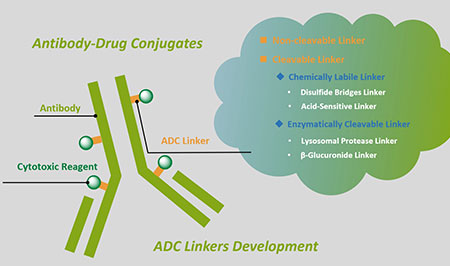1.Understanding chemical reactivity for homo- and heterobifunctional protein cross-linking agents.
Chen F1, Nielsen S, Zenobi R. J Mass Spectrom. 2013 Jul;48(7):807-12. doi: 10.1002/jms.3224.
Chemical cross-linking, combined with mass spectrometry, has been applied to map three-dimensional protein structures and protein-protein interactions. Proper choice of the cross-linking agent, including its reactive groups and spacer arm length, is of great importance. However, studies to understand the details of reactivity of the chemical cross-linkers with proteins are quite sparse. In this study, we investigated chemical cross-linking from the aspects of the protein structures and the cross-linking reagents involved, by using two structurally well-known proteins, glyceraldehyde 3-phosohate dehydrogenase and ribonuclease S. Chemical cross-linking reactivity was compared using a series of homo- and hetero-bifunctional cross-linkers, including bis(sulfosuccinimidyl) suberate, dissuccinimidyl suberate, bis(succinimidyl) penta (ethylene glycol), bis(succinimidyl) nona (ethylene glycol), m-maleimidobenzoyl-N-hydroxysulfosuccinimide ester, 2-pyridyldithiol-tetraoxaoctatriacontane-N-hydrosuccinimide and succinimidyl-[(N-maleimidopropionamido)-tetracosaethyleneglycol]ester.
2.Localization of a site of intermolecular cross-linking in human red blood cell band 3 protein.
Jennings ML, Nicknish JS. J Biol Chem. 1985 May 10;260(9):5472-9.
Subunit interactions in the band 3 protein of the human red blood cell membrane have been examined by a combination of cross-linking, chemical labeling, and in situ proteolysis. In agreement with Staros (Staros, J. V. (1982) Biochemistry 21, 3950-3955), we find that the membrane-impermeant active ester bis(sulfosuccinimidyl) suberate (BSSS) cross-links band 3 in intact cells to a dimer, with no formation of higher oligomer. Combined cross-linking of the outer surface with BSSS and the cytoplasmic domain with Cu2+/o-phenanthroline does not produce significant covalent tetramer of band 3 (beyond that produced by Cu2+/o-phenanthroline alone). Therefore, the membrane domains and cytoplasmic domains of the same pair of subunits are cross-linked to each other. 4,4'-Diisothiocyanodihydrostilbene-2,2'-disulfonate (H2DIDS) is known to form a covalent cross-link between complementary chymotryptic fragments (Mr 60,000 and 35,000). Edman degradation of band 3 from H2DIDS/chymotrypsin-treated cells shows that the H2DIDS cross-link is between fragments of the same subunit.
3.Intramolecular cross-linking of oxy hemoglobin by bis sulfosuccinimidyl suberate and sebacate: generation of cross-linked hemoglobin with reduced oxygen affinity.
Manjula BN1, Smith PK, Malavalli A, Acharya AS. Artif Cells Blood Substit Immobil Biotechnol. 1995;23(3):311-8.
The sulfosuccinimidyl esters of suberic and sebacic acids readily introduce intramolecular crosslinks into oxy HbA at pH 7.4, the relative efficiency of crosslinking by the suberate ester being slightly higher than that of sebacate. Nearly quantitative intramolecular crosslinking of HbA (0.5 mM) is achieved at pH 7.4 and 4 degrees C by using 5 and 10 fold molar excess of the suberic and sebacic acid, respectively. In contrast to the facile crosslinking reaction seen with the bis sulfosuccinimidyl sebacate, bis sulfosuccinimidyl sebacate and bis (3:5 dibromo salicyl) sebacate did not introduce any crosslinking into HbA despite the fact that the 'crosslinking arm' of the two bifunctional reagents is the same. The discrepant reactivity of the two reagents demonstrates the 'steering' influence of the negative charge of the leaving group of the reagent, namely sulfo succinimidyl moiety to specific domains of HbA rich in positively charged groups.
4.Distance restraints from crosslinking mass spectrometry: mining a molecular dynamics simulation database to evaluate lysine-lysine distances.
Merkley ED1, Rysavy S, Kahraman A, Hafen RP, Daggett V, Adkins JN. Protein Sci. 2014 Jun;23(6):747-59. doi: 10.1002/pro.2458. Epub 2014 Apr 3.
Integrative structural biology attempts to model the structures of protein complexes that are challenging or intractable by classical structural methods (due to size, dynamics, or heterogeneity) by combining computational structural modeling with data from experimental methods. One such experimental method is chemical crosslinking mass spectrometry (XL-MS), in which protein complexes are crosslinked and characterized using liquid chromatography-mass spectrometry to pinpoint specific amino acid residues in close structural proximity. The commonly used lysine-reactive N-hydroxysuccinimide ester reagents disuccinimidylsuberate (DSS) and bis(sulfosuccinimidyl)suberate (BS(3) ) have a linker arm that is 11.4 Å long when fully extended, allowing Cα (alpha carbon of protein backbone) atoms of crosslinked lysine residues to be up to ∼24 Å apart. However, XL-MS studies on proteins of known structure frequently report crosslinks that exceed this distance.







